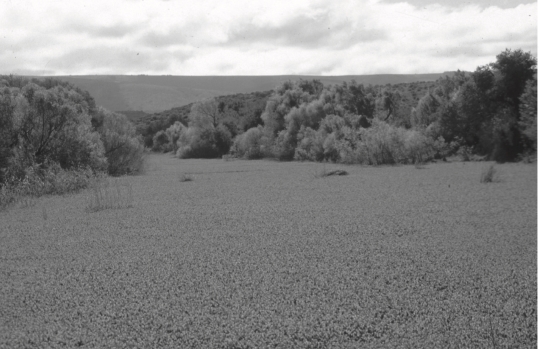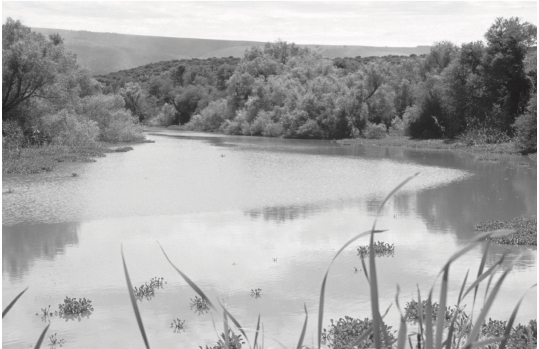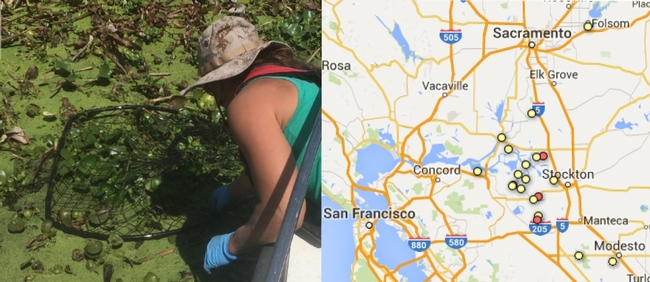What if you could reduce cover and biomass of invasive aquatic weeds, such as waterhyacinth, all while sitting back with a glass of lemonade and watching nature do its job? No herbicides, no mechanical control, and no clogged up marinas or waterways. Bonus part is that this control scheme ideally lasts forever. Sounds pretty good, right? Well, this is the idea behind biological control.
In classical biological control, a pest's natural enemies (for example, waterhyacinth insect herbivores) are collected from its geographic center of origin and released into the invaded region. Successful biocontrol agents can reduce pest populations below threshold levels that cause problems for humans and native species. Once established, biocontrol agents can provide a sustainable, long-lasting management option:
- Biocontrol agents are self-reproducing and self-distributing.
- Although biocontrol agents will not eradicate every target pest individual, this prevents population crashes of the agent and the pest.
Biological control of waterhyacinth has been implemented worldwide, with successful control achieved in parts of Australia, China, East Africa, the Gulf Coast States in the USA, India, South Africa, and Mexico.
In the Sacramento / San Joaquin Delta, biocontrol agents for waterhyacinth were first introduced in 1983, including two weevils (Neochetina bruchi and N. eichhorniae; Coleoptera: Curculionidae) and a moth (Niphograpta albiguttalis; Lepidoptera: Pyralidae). More recently (2011-2013), a planthopper (Megamelus scutellaris; Hemiptera: Delphacidae) was released in the Delta. Although biocontrol of waterhyacinth has been successful in other regions, the current biological control agents have not performed at acceptable levels in the Delta.
I am investigating both abiotic and biotic mechanisms that may be hindering biological control of water hyacinth in the Delta, with a particular focus on the weevil N. bruchi. Potential mechanisms that I am investigating include: 1) the effect of cold temperatures on the weevil's growth, survival and performance; 2) the presence of pathogens in N. bruchi; and 3) population genetics - including investigation into genetic bottlenecks and the potential of hybrid-breakdown (via hybridization with N. eichhorniae). The latter entails sequencing and analyzing mitochondrial DNA (COI) to create species barcodes (small regions of COI sequences) to identify and separate N. bruchi from N. eichhorniae, in addition to analyzing the variation in repeating regions of nuclear DNA (microsatellites) across populations of both weevil species from around the globe. From microsatellite DNA analysis, in combination with temperature performance studies, we will determine whether cold-adapted biotypes of the weevils exist, with the hopes of improving biological control of water hyacinth in more temperate regions such as the Sacramento / San Joaquin Delta.
So far we have examined spatial and temporal patterns of weevil densities in the Delta and its associated river systems, and I have designed COI markers to differentiate the two species of Neochetina weevils. We are in the process of publishing this work with others at the USDA and submitting these to GenBank. This is important work, as the morphological characteristics identifying these two species are not always clearly distinguishable (see images ‘C' & ‘D' below). With this technology, we determined that N. eichhorniae is still in California, just south of the legal Delta boundary near Modesto. Microsatellite marker development is underway. Once this is complete, I will be able to determine whether hybrids of N. bruchi and N. eichhorniae exist in the Delta, examine whether genetic bottlenecks of these biological control agents exist, and identify genetically distinct populations of the two Neochetina spp. around the globe.
Lastly, regarding the presence of pathogens- I have found the presence of an unidentified microsporidian species in N bruchi. Microsporidia are a diverse group of intracellular pathogens related to the Fungi and can negatively impact insect populations. I am currently working to identify this species and determine the abundance in populations of N. bruchi in the Delta. So far it appears that this pathogen is low in abundance and unlikely to be the main limiting factor for N. bruchi in the Delta. However, stay tuned as this work is still ongoing! Check out my website for more updates at: www.juliehopper.wordpress.com
Dr. Julie Hopper is a Delta Science Postdoctoral Fellow at UC Davis in Dr. Ted Grosholz's laboratory and is working to improve the biological control of water hyacinth in the Delta with Dr. Louise Conrad from the Department of Water Resources, Dr. David Boubenheim from NASA, and several researchers at USDA-ARS including Dr. Paul Pratt.



